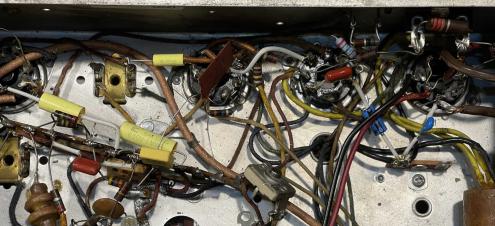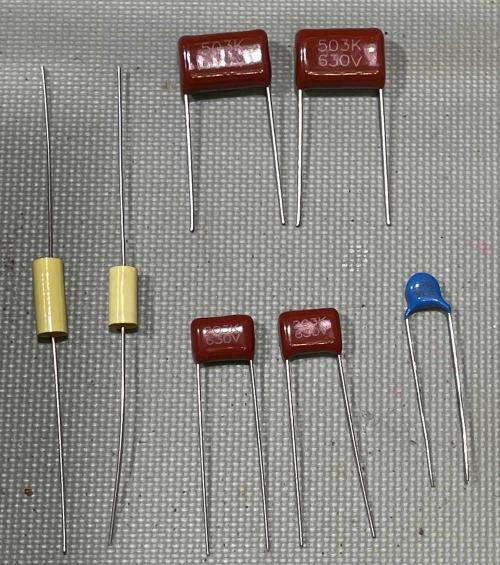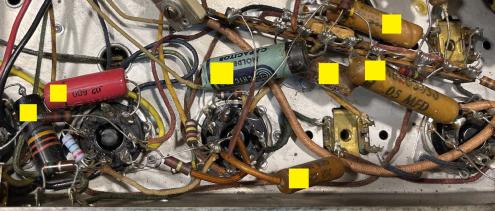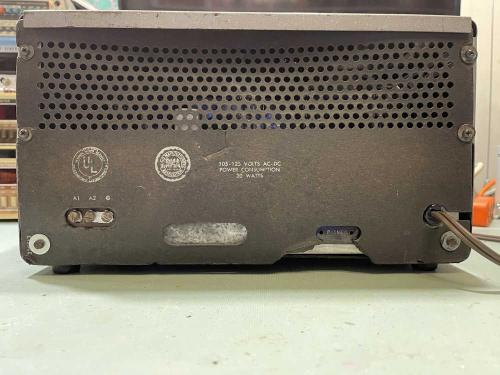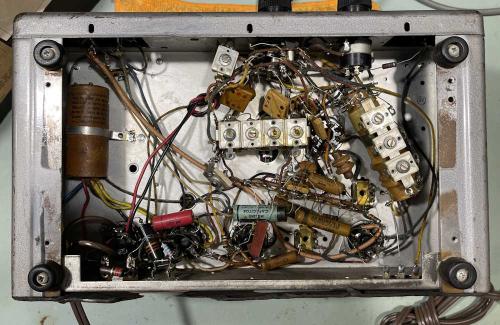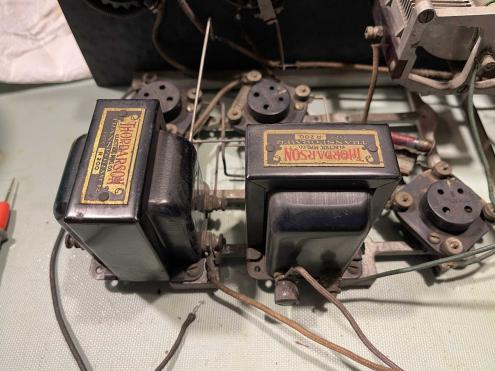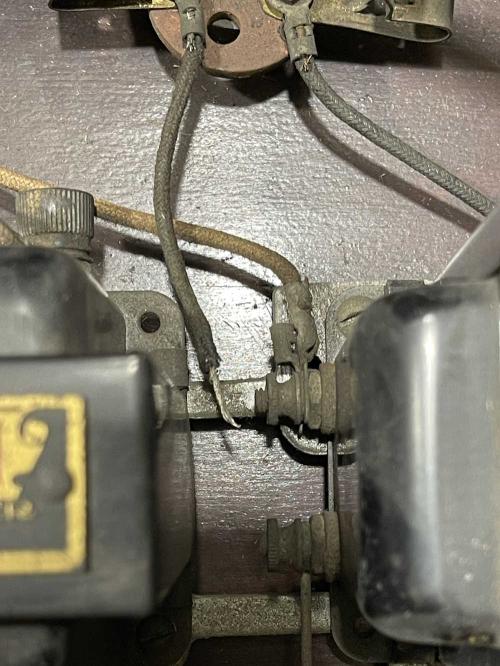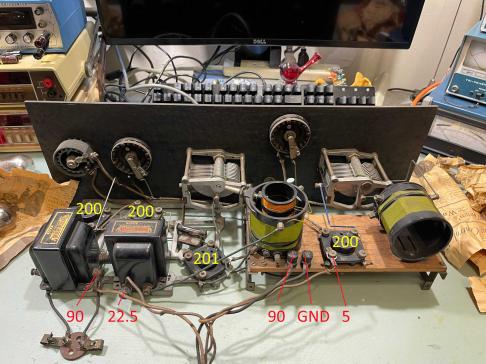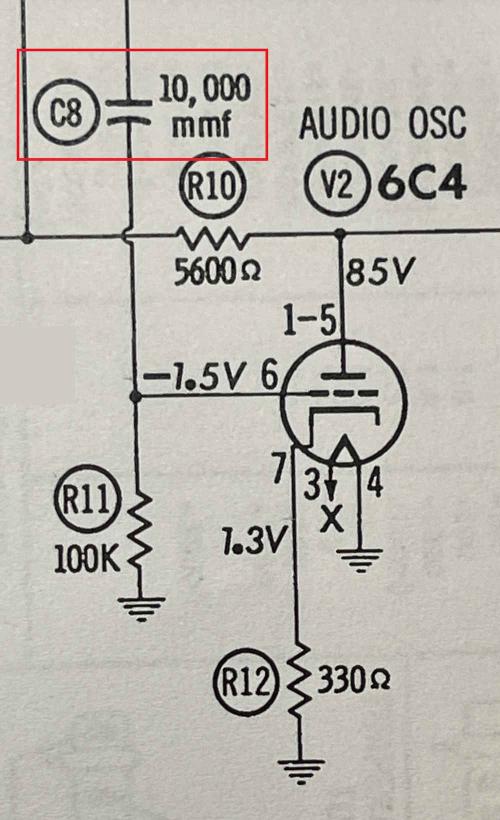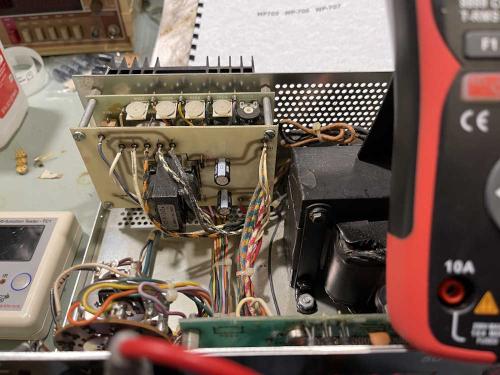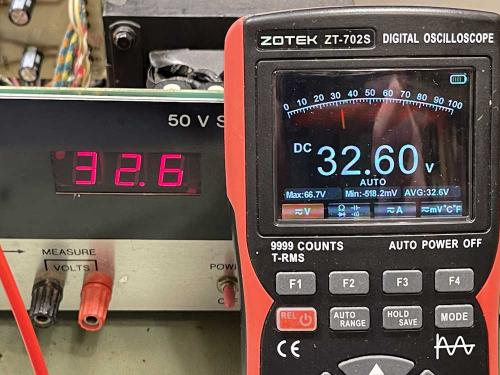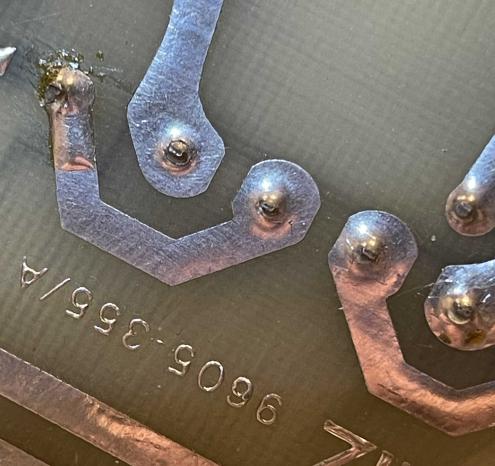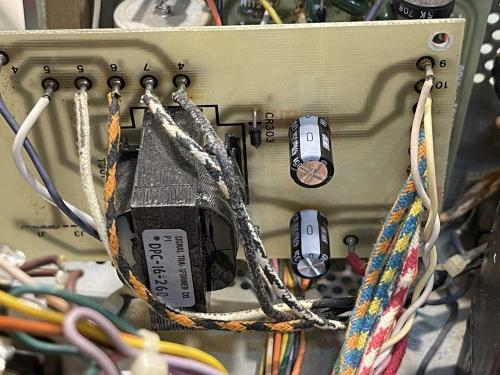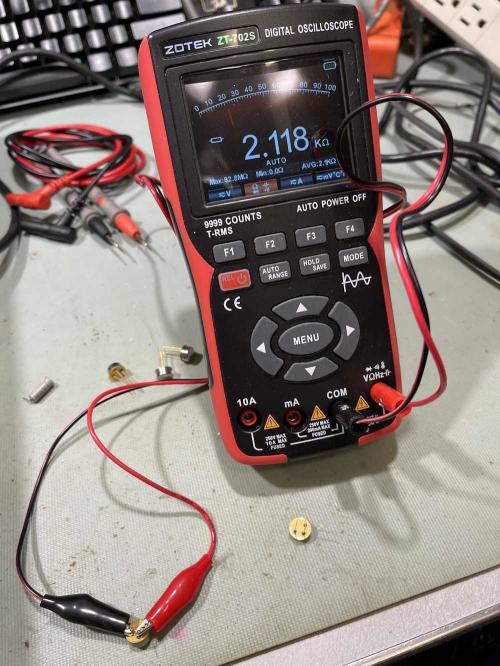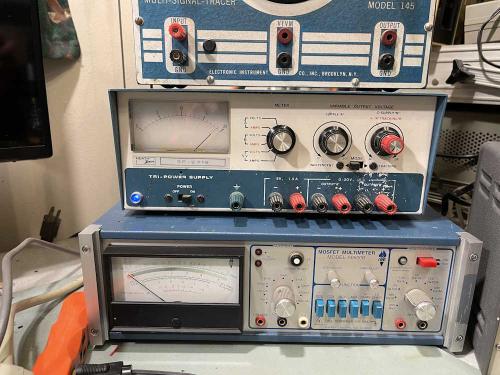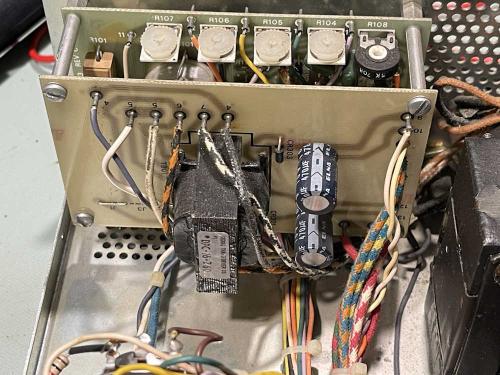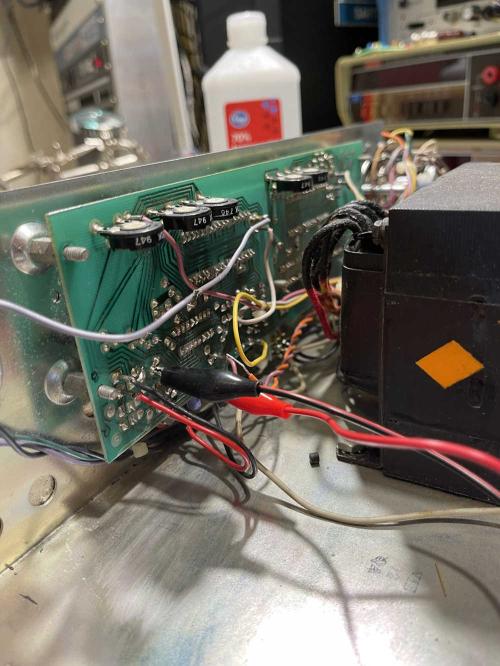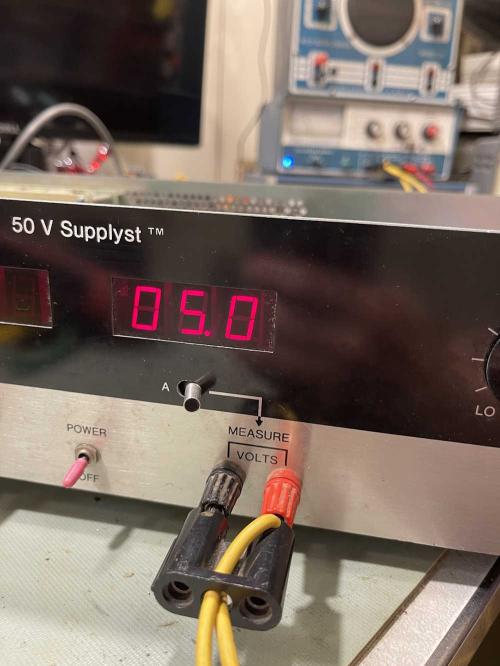- 2025
- Dec
- 22
Another S-38C on my bench, part 4: Installing the parts.
Working inside a wild chassis is always an exercise in delicate maneuvers…you have to get in to places without burning or breaking other components that might be unreplaceable. I’ve spent a few hours replacing the paper capacitors in this Hallicrafters S-38C. At least, the ones I know of, some of the postage stamps might also be paper…but the majority of the problem devices are gone, modern parts in their place.
This one has been a bit different. For most of my projects, I’ve been gutting the chassis and starting over. Not here - the old stuff must remain because this is a more complex device with a lot of inductors and adjustable capacitors for the various frequency bands. I did take the time to move some of the parts to more convenient locales, however - mostly necessity as some of the new ones don’t reach as far as the old ones did.
I did choose some different parts after studying where they actually lay in the circuit. The yellow boxy part and the blue drop are both safety capacitors, chosen because these tie the line to various points like power and chassis ground. The remaining parts are regular film devices.
I haven’t soldered everything yet, I want to give it a final look over with schematic in hand. But, another hour or so, and this device is ready to play once more. Well, at least some of the local AM stuff, there’s just not much on SW these days that this thing can hear.
Time to clean the wax off my fingers and pull the schematics, and then clean the wax off of the new parts. That stuff gets everywhere!
- 2025
- Dec
- 9
Another S-38C on my bench, part 3: We have parts!
In the last installment, we talked about getting parts for the Hallicrafters S-38C. Justradios.com comes through again with values marked per the schematic.
I have exact values as per the schematic, not that it really matters too much. But, if you can get them, why not?
2 x 0.05μF
2 x 0.02μF
1 x 0.01μF
1 x 0.002μF
and
1 x 0.022 for the across-the-line capactitor.
I’ll probably get to this in a couple of weeks, as there’s some holiday prep that needs to be accomplished this weekend.
- 2025
- Nov
- 29
Another S-38C on my bench, part 2: Parts
I’m only going to replace the leaky capacitors on this unit, so I’ve identified the following parts:
All of the parts marked with a yellow rectangle need to go. These are probably leaky enough that they could potentially cause issues with the device, and that black bumblebee part is a known problematic unit.
I’m going to order these pars if I don’t have them in stock, all @ 630V except the across-the-line ‘bee. Those have their own ratings, and I have plenty in stock.
2 x 0.05μF
2 x 0.02μF
1 x 0.01μF
1 x 0.002μF
I’ll probably just order my standard yellow films unless I can get a good deal on another type.
Edit: I got a good deal on some other types from justradios.com.
Stay tuned, there will probably be another post or two before we wrap up 2025!
- 2025
- Nov
- 26
Another S-38C on my bench, part 1: Examination and Diagnosis.
Last year at Dayton, I had purchased an S-38C because I wanted another example, having had one when I was younger. Unfortunately, while I found one, it seems to have silver-mica disease. Really, really bad. So the hunt was on for another one.
I found this one at Findlay 2025:
It’s in decent enough shape. Back and bottom covers are present, even though the paper is deteriorating.
Inside, it shows a little work. Some new resistors, a filter that’s been resoldered, and a new power cord.
I’m going to replace the 6 tubular capacitors in this one so it’s somewhat safe to use. Of biggest concern, of course, is the bumblebomb present across the line. That absolutely must go.
Other than that, the filter is in good shape, so it stays for now.
Stay tuned for the next part of this series where we determine what parts we actually need!
Next part of this series: Coming soon.
- 2025
- Nov
- 24
An Unknown 2-dial TRF radio part 4: Full stop.
In the last part, we identified where the power connects. This part is about checking coils and transformers to identify any problem areas.
And…there’s a problem. The AF output transformer is open on the side that supplies the plate voltages. This is the leftmost transformer in the image.
While the Thordarson R-200 transformer was a common part for this type of radio, and they are out there in resale land…good examples can go for a bunchabuxx. Bad examples can still be somewhat expensive.
For now, this project stops. I’m not willing to invest a lot of money into what would ultimately be a gee-whiz device. I’ve whittled options down to these:
1: Find a transformer at a show. Perhaps Dayton or Cuyahoga Falls will have one at a reasonable price.
2: Try to open this one up without damaging the crimp ears that keep the mounting plate on the body.
3: Donate it to the Early Television Museum’s operating funds auction in the fall.
I’m thinking #3 is going to be the winner here, as I have plenty of other devices to work on. Stay tuned, this may yet show up in a future post.
Next part of this series: None at this time.
Previous part of this series: https://wereboar.com … s-inside-identified/
- 2025
- Nov
- 24
An Unknown 2-dial TRF radio part 3: Things inside identified.
When last we met, I had identified where the tubes went, so now it’s time to figure out where the power supplies need to connect. This looked very complex at first, but once I started reading about this type of radio, it became obvious how things were supposed to connect. But first, some other things to take care of.
There are a number of broken connections here. The original builder used some very precise bent wires in spots, and made “meh it has to connect” connections in others. Some of those have broken because they were just laid on their connection point without any kind of mechanical connection, and hit with a blob of solder. There’s even some solder blobs in the case indicating repairs were made in situ at times.
The first is the RF amp. This one was just laid on it’s terminal and soldered.
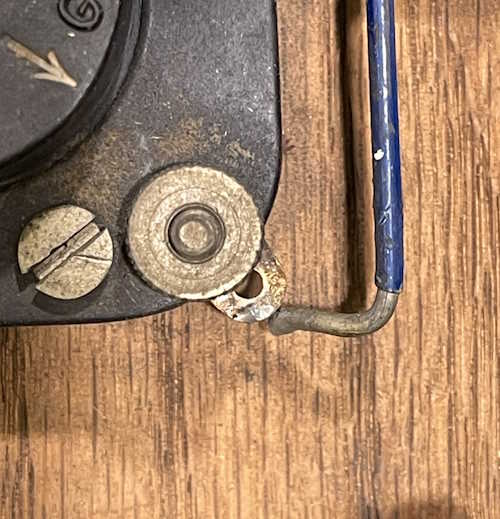
This one was resting against it’s connection point and poorly soldered.
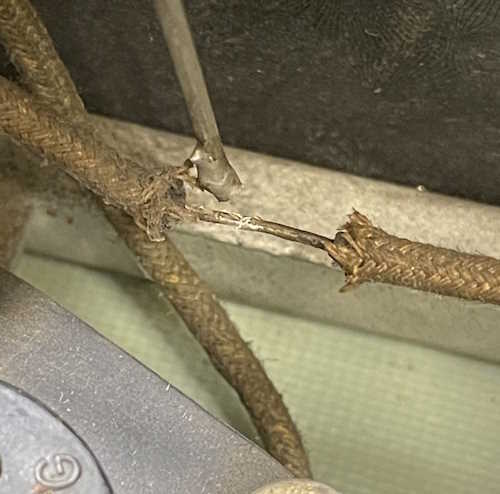
And the final one is just a wire that pulled out of a poorly crimped fork. This one is the 90V supply feed for the final AF amp, and uses the headphones as it’s bias.
With that out of the way, it’s time to move on to identifying the battery connections. I’ve already identified the tube layout, so it was mostly a matter of tracing back to see where the plate of each tube went. It threw me for a minute that the detector and final AF amps both connection via one of the interstage transformers, but that’s how these were built.
I found it interesting that the unit has two 90V connections, but then it occured to me that the builder was trying to keep RF out of the AF to prevent squealing. If you’ve ever had a radio with a bad AGC capacitor, you know what I mean…
Before applying power, there’s going to need to be some substantial cleanup. All connections are oxidized to the point of insulation - the power switch, for example, doesn’t even read resistance when closed. The tuning gangs are locked up tight, and the battery cables are no longer conductors.
The next step is to check coils and transformers to make sure all are giving a useful reading. Stay tuned!
Next part of this series: https://wereboar.com … io-part-4-full-stop/
Previous part of this series: https://wereboar.com … fying-things-inside/
- 2025
- Nov
- 17
A PACO G-30 RF Signal Generator - Part 8: So we meet again
You probably remember this thing:
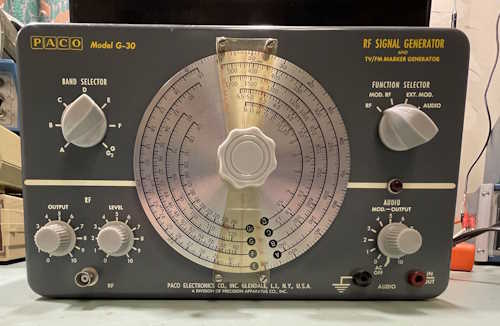
It wasn’t that long ago that this was wrapped up. (See the bottom of this post for that entry.)
However, a friend pointed out that the schematic didn’t match the unit. In particular, a capacitor in the audio oscillator wasn’t per the information:
C8 is a 103, aka 0.01μF capacitor, per the schematic. However, what’s in the unit:
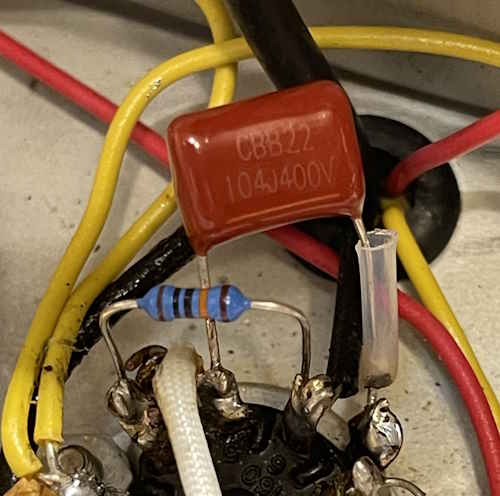
That’s very clearly a 104, aka 0.1μF part. Note that the resistor in the image is the one that was incorrect and replaced in a previous post.
No problem, I have plenty of 0.01μF left over from various rebuilds. One goes in easily:
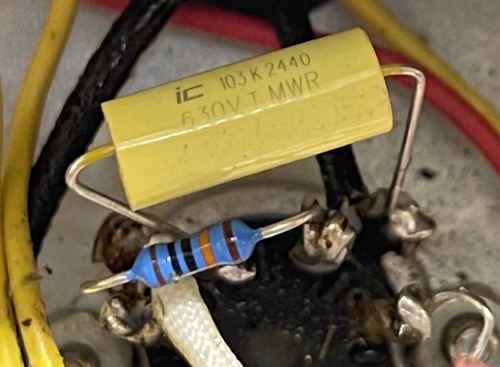
And,
It won’t oscillate. Okay.
The old part goes back in, and all is well. It’s oscillating again, right around the 499Hz it was the last time we looked at this unit.
So, what gives here? Well - I’ve found that many of these devices didn’t exactly follow the manufacturer’s information. Schematics were often printed before the unit was manufactured, and things changed. Problems were corrected, circuits were changed, new variants were released - all kinds of things that make what you have on the bench and what you see on paper deviate. You literally have to expect the unexpected here, or you’ll go crazy trying to figure out what happened.
I assume that the original owner probably put this part in, after discovering the same thing about the oscillator. Regardless, it’s back the way it was and bolted together again, waiting for it’s time to shine.
Previous part of this series: https://wereboar.com … rator-part-7-wrapup/
- 2025
- Nov
- 17
A Viz WP-705 Power Supply part 5: Wrapup and final thoughts.
This was an interesting device that required following a fault back to what was (most likely) it’s original source.
I’m going to assume that the regulator was probably destroyed by the noise spikes coming from the power supply transformer’s broken leads - either the spikes in the voltage caused it, or the excessively low voltage eventually destroyed the device. Who knows, but ultimately, the regulator was bad and the transformer board needed a complete re-solder.
In addition to the regulator board, there were a couple of 4.7μF capacitors on the display board - those were replaced, as were the 470μF capacitors on the display supply. There are larger capacitors on the actual regulator board, and those will need to be replaced as well - but they’re oddball sizes and will take some finding.
The last thing is to calibrate the display as best I can. While I have a manual, it’s of no use here because it’s for a different rev. I eventually discovered that the potentiometers on the display board calibrate the external measurement, and then the internal measurement. This was just turning them slightly and seeing what happened, and it was easy enough to dial in the correct values.
It was then buttoned up, ready for use. I’m not going to talk more about the calibration, since all of these seem different - but don’t be afraid to turn things just a tiny bit to see what happens, but always be aware of what you could be causing before doing so! Make sure you can fix it if you break it.
The two takeaway points on this were:
The manual you can purchase, while it claims to be the correct one (and mine is indeed for the WP-705) may not be the correct one, especially if the manufacturer assumed lines from another company.
The fault you see up front isn’t always the cause of the problem. In this case, tracing all the way back to the input revealed what probably caused the issue here.
With that, this unit goes on the shelf, waiting for it’s use. I suspect it’s going to see service with a coming project, something where some oddball voltages are needed. Stay tuned!
- 2025
- Oct
- 28
A Viz WP-705 Power Supply part 4: The fix is in.
We left off with the regulator issue fixed, but still having a problem. There’s not that much more that can be wrong, so let’s move on to the isolated supplies that feed the regulator.
This is a simply supply consisting of two transformer windings (one for each side,) a diode, and a capacitor to make a half-wave power supply. Originally I thought that it might be dried out capacitors, but there’s no reason not to check everything in there. Diodes and transformers all were in acceptable ranges…but in the process, it showed itself.
The ‘ol “Vertically mounted heavy transformer (with short leads) on a PCB” trick.
You can clearly see a crack in the solder, and that’s in the side of the supply with the issue. You can also see the other leads beginning to develop cracks, so it wouldn’t be long before those leads were also broken. Since I’m in there, I replaced the capacitors I originally suspected (they’re old) and reflowed every joint on this board.
And, it works.
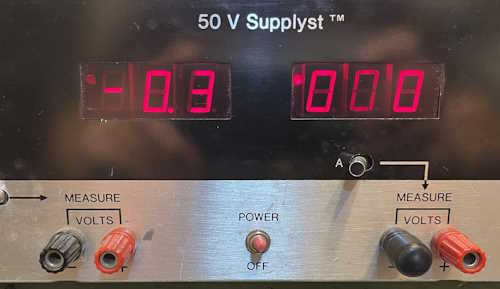
I want to replace the main filters at some point as well, but that’s a higher voltage part and I don’t have any in stock that fit the area. I’ll order something and revisit this unit later.
That pretty much takes care of this unit, but it still needs some tweaking on the display calibration. Hopefully the manual is close enough on this that I can assume a cal procedure from it. One more part on the way, stay tuned!
- 2025
- Oct
- 22
A Viz WP-705 Power Supply part 3: Troubleshooting in stages.
In part 2, we discovered that the 5V rail for the display was bad. At this point, I decided to pull the regulator out and see what was going on. I wanted to get a manual and find some LM309H spares before going further than part removal, and I found both.
The manual, unfortunately, wasn’t helpful, as it was for the wrong revision of device. I found some LM309H regulators, so off we go.
I started by measuring the regulator itself with a simple ohms test. The part I have read 2KΩ from terminals to ground, and that’s not right. A new part reads about 30MΩ to ground from each terminal, so the part in the unit is defective, and is probably causing the output voltage to be low.
Before I put the new part in, however, I wanted to check the A/D and driver. So…out comes the trusty old Heath/Zenith supply, set to 5V.
I injected 5V into the regulator output terminal pad, and the display came back without issue. That’s good - those chips are expensive these days, and while I have a spare, I’d rather not use it unless needed.
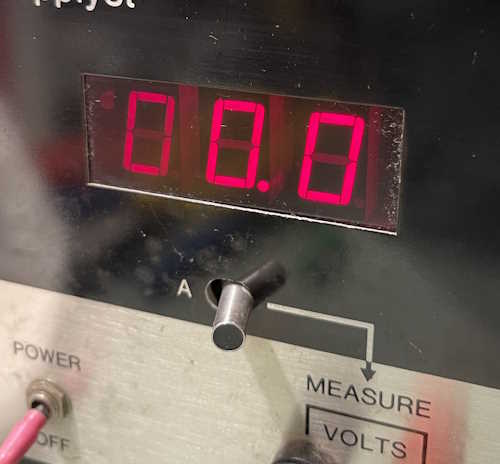
The new regulator is installed, and main power is applied while monitoring 5V. There’s still an issue, the display is still rolling. Measuring the input reveals the problem, you can’t regulate 5V from 4.5V…
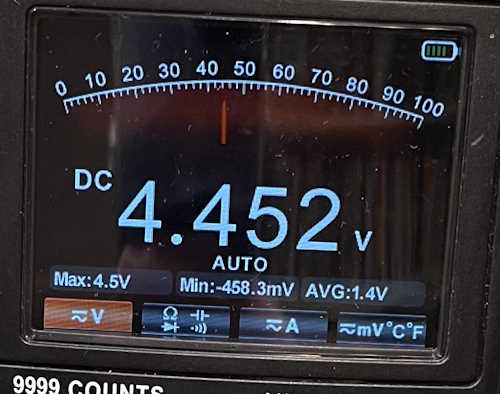
So, what’s wrong here?
The 5V supply is provided by an unregulated supply that floats at about 9V under load. It’s a simple affair, a transformer, diode, and a capacitor for each side. This provides isolation from the main supply and doesn’t bleed off your supply current to run the device itself.
There’s only really three things that could be wrong:
1: The transformer is bad.
2: The diode is bad.
3: The capacitor is bad.
Chances are…it’s number 3. I’d guess if I scoped this, I’d find that the output of the supply is nothing but ripple because the filter is dried out. I need to get some 470μF parts of known quality to replace the ones in here in order to check, as all I have in stock is what I purchased at Radio Shack from one of their parts kits - back in the 90s…
In the meantime, I disconnected the unregulated input, and applied 10VDC to the input of the regulator.
And the device came right up, and I was able to use it’s input to measure 5V from the external supply. It’s quite a ways off (this should be closer to 5.8VDC) so there’s going to be some tweaking needed once we’re all back in operational order.
Stay tuned for part 4 where the capacitors in the supply’s supply get replaced.
Next part of this series: Coming soon.
Previous part of this series: https://wereboar.com … 2-musings-on-faults/
